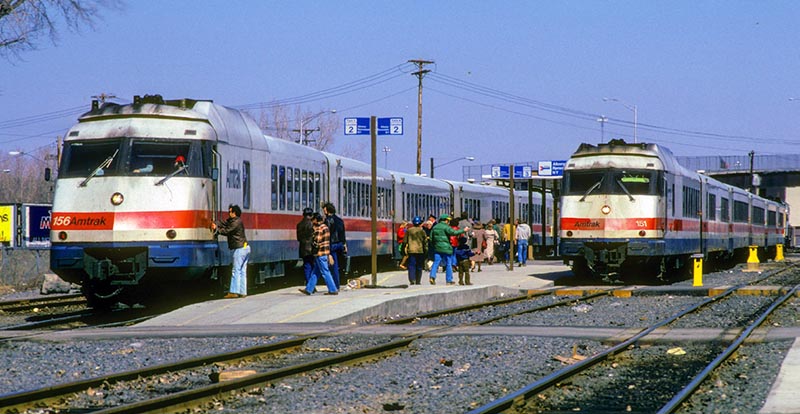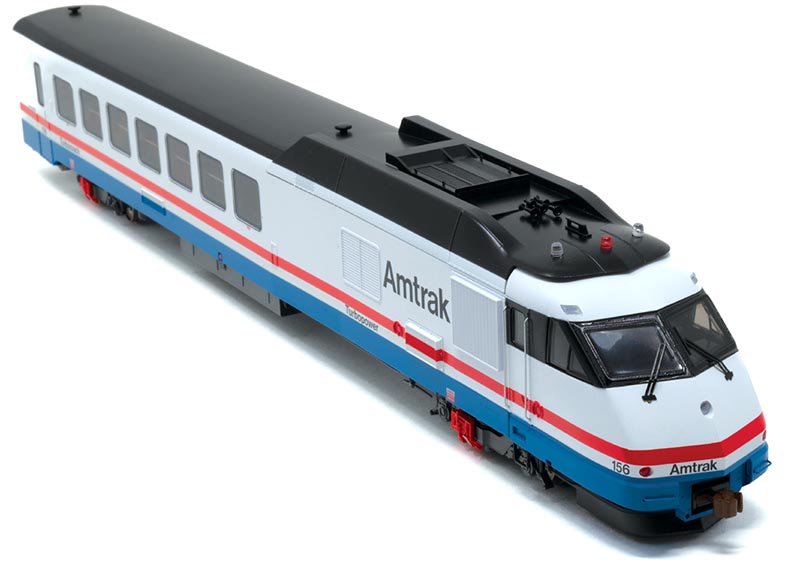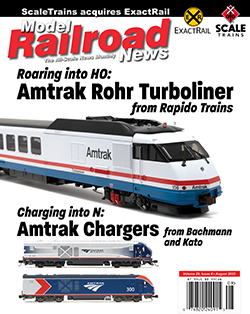Rapido Trains delivers its initial offering of another interesting North American prototype with the arrival of this Rohr Turboliner set. Packaged in a handsome 16-inch wide by 20-inch tall cardboard case are five finely detailed HO-scale reproductions of this intriguing and most-recent Amtrak (AMTK) gas-turbine, self-propelled passenger train.
The prototype debuted in 1976, not long after a French import paved the way for this design. An early attempt by Amtrak to improve and innovate an important Midwest corridor service (Chicago to St. Louis) saw ANF-Frangeco-built gas-turbine sets brought to the U.S. (with relatively minor modifications) and placed into service. After initial success, Amtrak enlisted California-based Rohr Industries to build an American version of the French turbo train. Neither of these 1970s turbos is to be confused with United Aircraft (UA)/Sikorsky’s 1967 turbo (also reproduced in HO and N by Rapido Trains), which was developed by the U.S. Department of Transportation and Pennsylvania Railroad. Together, this trio of prototypes gained the attention of rail passenger travel and the locomotives remain popular with train enthusiasts.

ABOVE: Amtrak Turbopower 156 (one of the power units featured in this review) appears at the left with Train 62, while AMTK 151 visits Albany, N.Y., with Train 56 on March 28, 1982. Both Rohr Turboliners are dressed in Amtrak’s Phase III paint scheme; however, notice this early 1980s look shows road numbers in white and Amtrak’s name in black in the red band wrapping around the nose. —Jim Conroy photo, Kevin EuDaly collection
Rohr’s turbo designs mirrored the French example, with power units on the ends and two car styles (coach and food service), placed between the rounded end power units, making the rest of the consist. Amtrak’s roster included the late 1960s United Aircraft equipment numbered in the 50s. The French RTG trains followed (beginning at AMTK 59), with the roster mixed through AMTK 97 with UA and ANF units. Rohr’s RTL equipment joined the Amtrak roster in 1976, originally taking up residence in road numbers 150 to 190.
After approximately two decades of service, rebuilding and updating of the trains was considered. An RTL-II trainset appeared in 1995, followed by an RTL-III effort; however, the projects were limited and by 2004, all Rohr-built trains were reported to be retired.

ABOVE: Among the era-specific features Rapido includes for its Rohr Turbopower tooling are variations to the grilles. Surrounding the Amtrak name on this side of the power unit are the grilles mentioned; their size changed over the years and this is provided for in the tooling of this set. The selection of lights on the roof also varies, depending on the era. The power unit with its shell removed (center of this page) shows the drive mechanism resides up front over the lead truck. Both end units are powered.
Rohr’s RTL in HO
Rapido Trains has built its name on some uncommon prototypes — recent examples include New Haven’s EP-5 and FL9, as well as the mentioned UA Turboliner. The company’s Jordan Smith is credited as helping champion this Rohr train into existence. We all have odd or interesting favorites, and I can only imagine the excitement and anxiety Jordan experienced during the process of bringing these HO-scale models to market.
To its credit, Rapido Trains appears to have a success with this first produc-tion of Rohr RTL equipment. The set arrives in an impressive way in a large, colorful cardboard package. The five models making up the trainset are each individually and securely held in clear plastic cradles with outer protective sleeve, and nestled into a foam-lined inner section. 24-page manual, two exploded parts diagrams, and a color poster are the printed materials in this set. A cutout area in the foam is home to several parts bags and Rapido’s magnetic wand for on/off control of interior lighting in the set…




